The emergence of zygoma implant method has opened up a new advancement in the treatment of severe maxillary bone resorption for dental implantation. However, many patients still hesitate and wonder whether zygomatic implantation truly brings success for cases of complete maxillary tooth loss or severe bone resorption. If you are interested in zygomatic implantation, do not overlook the following article by BeDental.
What is zygoma implant?
What is zygoma implant? Zygomatic implantation, nobel zygoma implants also known as Nobel Zygoma implants in English, is a treatment method designed for patients with tooth loss in severe maxillary bone resorption conditions where conventional implantation techniques are not feasible.
Introduced by Professor Branemark, a master in the field of dentistry in 1998, this zygomatic bone grafting technique was developed to address the needs of patients who cannot undergo regular implantation due to severe bone resorption, have previously failed conventional implantation, have had parts of their jawbone removed after cancer treatment, or have craniofacial abnormalities.
See more: Do braces cause toothloss?
According to leading experts, zygoma implant has a relatively high success rate, making it the most effective method for treating severe bone resorption, even in the posterior maxillary region.
Zygoma implant is recommended because the bone density in this area is higher than in the upper jaw, providing a solid foundation for safe grafting, enabling force transmission over a wide area, and successful implantation or bridgework at the time of surgery. Typically, this grafting is inserted from the inside of your mouth and may be combined with one or more conventional grafts in the anterior part of the jaw.
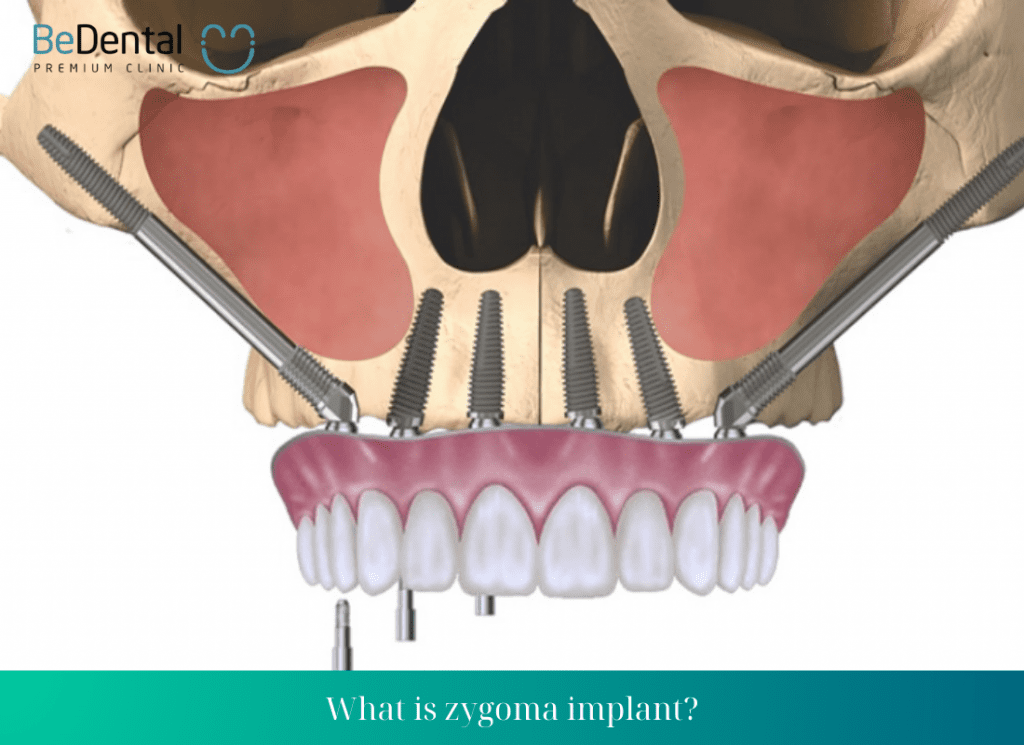
The difference between zygoma implant and regular tooth grafting
From a technical standpoint, zygomatic grafting is significantly longer than conventional tooth bone grafting. Although both methods are inserted through the mouth, zygomatic grafting attaches to the cheekbone, as opposed to the jawbone inside the mouth.
In terms of benefits, conventional tooth bone grafting can help treat maxillary bone resorption conditions and supplement bone volume for implant placement, but this method still has some disadvantages. These include the potential for rejection due to bone incompatibility, long healing times for wounds, a minimum bone integration period of 9-12 months, and cases of severe bone resorption where grafting is not possible.
See more: Dental crowns
On the other hand, zygomatic bone grafting can be applied to cases of long-term tooth loss, complete maxillary tooth loss, and severe bone resorption. The sturdy structure and high stability of the cheekbone allow for quick and secure implant placement.
When should zygomatic bone grafting be performed?
When should zygomatic bone grafting be performed? Zygomatic bone grafting is the most ideal dental treatment method for patients who are not suitable for regular tooth implantation. Therefore, eligible candidates include:
- People who have lost all teeth but have shrunken jawbones in the tooth region.
- Those who have had implants placed in the posterior tooth region to avoid sinus surgery and bone grafting.
- Zygomatic bone grafting is indicated as a replacement for sinus lifting and failed jawbone grafting for implant placement.
- Individuals with severe bone resorption or previous failed sinus lifting for regular implant placement.
- Those who have had jawbone removed due to cancer treatment or craniofacial abnormalities.
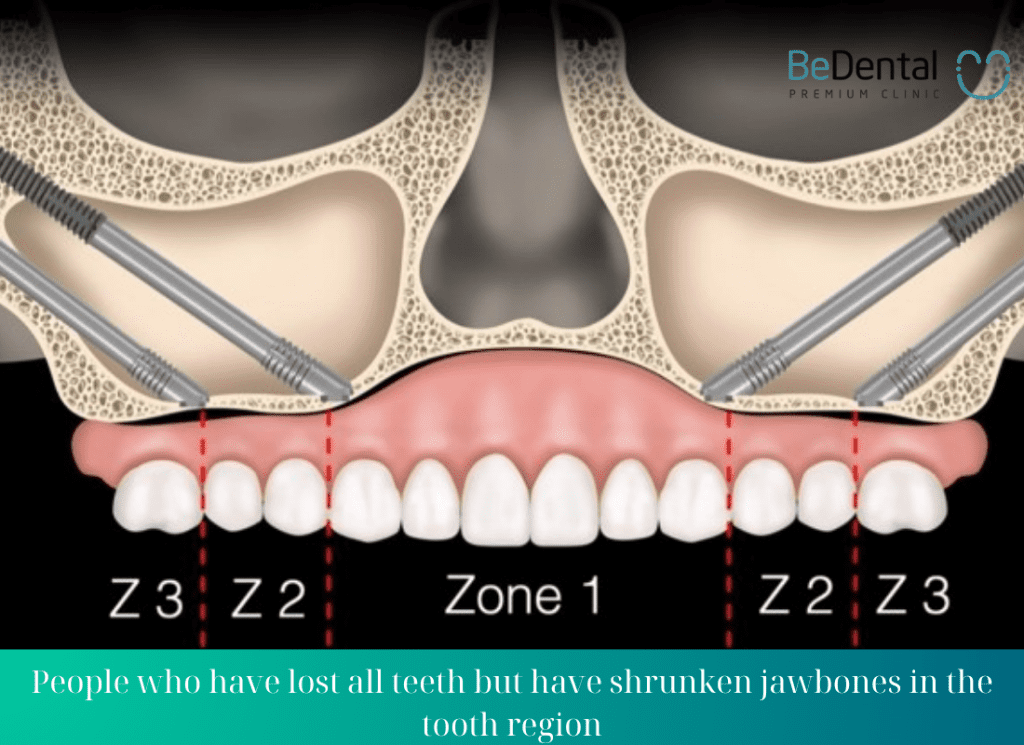
Should zygomatic bone grafting be used instead of tooth bone grafting?
Currently, many customers choose to use zygomatic bone grafting for aesthetic restoration in cases of long-term tooth loss or complete maxillary tooth loss. By using longer implant posts and directly grafting into the cheekbone, zygomatic bone grafting is the most superior solution for aesthetically restoring missing teeth.
However, many customers are still concerned about the safety and feasibility of directly implanting in the cheekbone as a replacement for tooth bone grafting. The answer is YES because zygomatic bone grafting can achieve many things that conventional tooth bone grafting cannot.
See more: Composite Veneers
Advantages and disadvantages of zygomatic bone grafting technique
Advantages of zygomatic bone grafting
It can be said that the development of zygomatic bone grafting has brought hope to patients who are not suitable for regular dental implantation. Additionally, this method is highly regarded for its effectiveness and safety compared to traditional bone grafting methods, specifically:
- Zygomatic bone grafting reduces the number of surgeries, thus shortening the hospitalization and treatment time significantly.
- After the grafting procedure, patients will have immediate temporary fixed teeth without the need to wait for future tooth grafting.
- It can immediately improve appearance, restore natural gum-to-tooth aesthetics, and restore confidence to patients.
- Patients can eat normally right after the procedure without worrying about teeth falling out.
- Zygomatic bone grafting is painless on the dentures and provides long-term support for teeth.
- It is a method that restores perfect chewing function for patients with shrunken maxillary jawbones who cannot undergo conventional implant placement.
- It avoids serious complications caused by bone grafting in corresponding areas such as the jawbone.
- It reduces dangerous complications and the need for additional implant grafting to support the front teeth due to stable implant anchorage achieved in the cheekbone.
- Zygomatic bone grafting also supports the treatment of patients with cleft lip and palate who cannot be aesthetically restored through other methods.
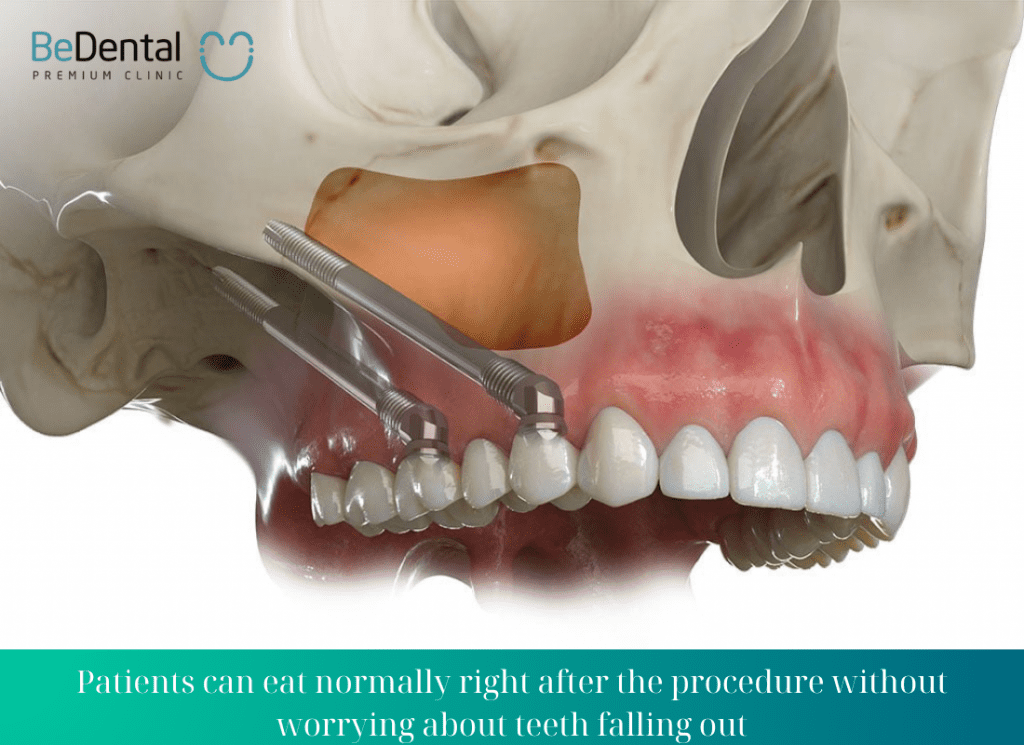
Disadvantages of zygomatic bone grafting technique
Despite having many outstanding advantages, the zygomatic bone grafting technique still has some disadvantages as follows:
Complications may still occur after the grafting procedure. Commonly, sinusitis can occur. However, with preoperative diagnosis and sinus evaluation, along with using a combination of extra-sinus surgical approaches, the entire zygomatic bone grafting procedure will ensure safety, reduce, or completely eliminate this complication.
More serious complications include nerve sensitivity under the eye socket, nasal sinus perforation, and eye socket perforation. These complications often occur when grafting is performed at non-standard dental facilities.
How is the zygomatic implant procedure carried out?
The zygomatic bone grafting implant surgery is a relatively complex technique because the implant trajectory is usually long and in close proximity to important anatomical structures. Therefore, the zygomatic bone grafting procedure must be performed not only by a team of skilled dental experts but also in a sterile operating room, where all pre- and post-grafting procedures are strictly standardized.
See more: Dental implant and Dental bridges
Specifically, Zygoma implants step by step as follows:
Step 1: Examination and development of a suitable treatment plan
The zygomatic bone grafting process is similar to conventional implant grafting but requires more in-depth technical handling. Therefore, the crucial step to take is to conduct an examination, assessment, and overall evaluation of the current oral health status.
The dentist will use dental X-rays and a Cone Beam CT 3D system to accurately assess the condition of the jawbone and the current tooth loss. Based on this, the dentist can develop an accurate treatment plan, ensuring the success rate for each tooth loss condition.
Step 2: Calculation of the implant post angle
Unlike conventional dental implantation, the dentist needs to graft bone into the cheekbone to ensure the implant post is securely held in place. Based on expertise and experience, the dentist will calculate the ideal angle and depth for placing the implant post to achieve the most successful tooth restoration result.
Step 3: Restoration of ceramic teeth on the implant post
After a period of time, if the implant post has integrated with the zygomatic bone area, the dentist will proceed with the restoration of ceramic teeth on the implant post.
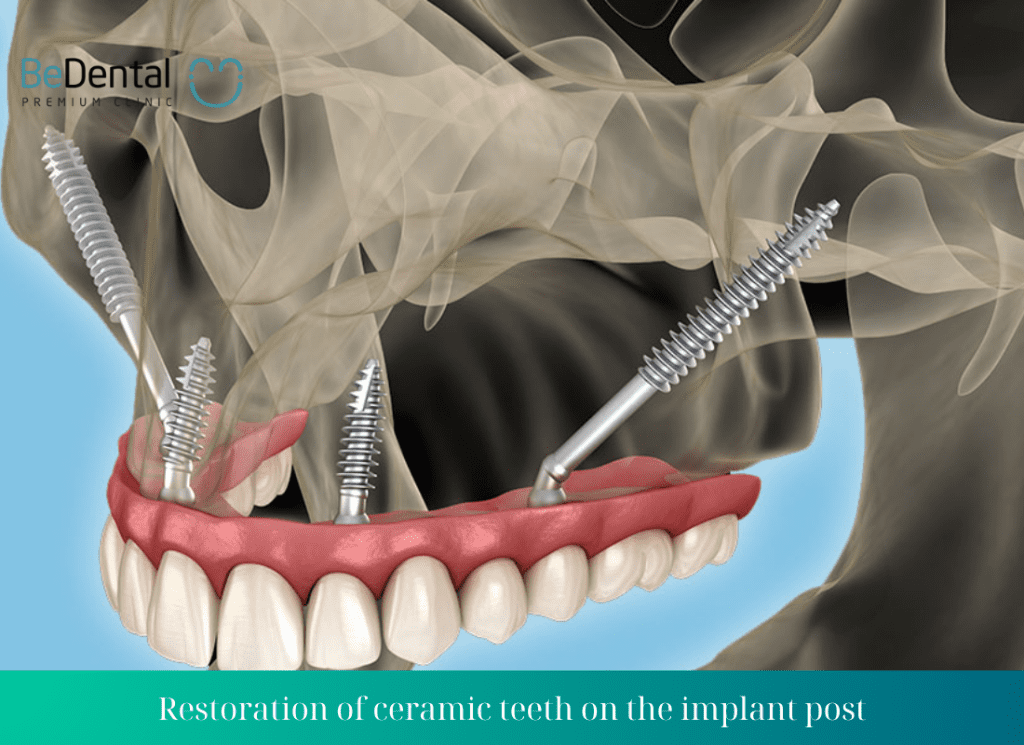
How much does zygoma implant cost?
Having many outstanding advantages compared to conventional bone grafting methods, zygoma dental implant is the choice of many customers when they need aesthetic restoration of missing teeth. As a new technique with complex technical characteristics, the cost of surgery, whether it is high or not, is always a concern for many customers.
Currently, there are many cosmetic dental facilities that offer zygoma dental implants at different prices. However, this is a difficult technique that requires a high level of expertise from the dentist, so you should not arbitrarily choose a dental facility that has not been evaluated for quality. In addition, you should be cautious about advertising tactics for cheap zygoma implants dental because there may be hidden risks of complications at those places.
To get the latest zygoma implant cost estimate, you should directly contact reputable dental facilities for consultation and specific pricing.
Furthermore, the zygoma implant surgery cost will depend on the type of implant post you choose for grafting. If you choose a post from a well-known brand with high longevity and compatibility, the price will certainly be higher than regular implant posts. Additionally, the type of ceramic tooth restored on the implant will also determine the total cost of zygomatic bone grafting implant.

Reputable address for affordable zygoma implant
The success or failure of a surgery depends greatly on the skills of the doctor. Moreover, zygoma implant course is a difficult technique that not every dentist can perform. Therefore, you should seek out reputable dental facilities like BeDental to have it done.
BeDental is a place that gathers a team of top-notch dental experts in the country. They are always proactive in improving their professional skills, eager to learn, and adopt new dental techniques. Therefore, since the zygomatic bone grafting implant technique emerged, BeDental’s dentists have been sent for extensive training in this technique.
See more: Zirconia Bridge and 5 Tips Should Know
Furthermore, to enhance the success rate of the surgery, BeDental also focuses on investing in machinery and infrastructure with fully sterile operating rooms that meet the standards set by the Ministry of Health. Thanks to all these factors, the process of implanting the post into the zygomatic bone is always accurate, quick, helping the bone integration process to occur rapidly with almost no dangerous complications or oral diseases.
Regarding the implementation costs, BeDental always provides specific pricing for customers to consider before proceeding. The cost is based on the examination results, initial assessment, and the type of implant post and ceramic tooth chosen by the customer.
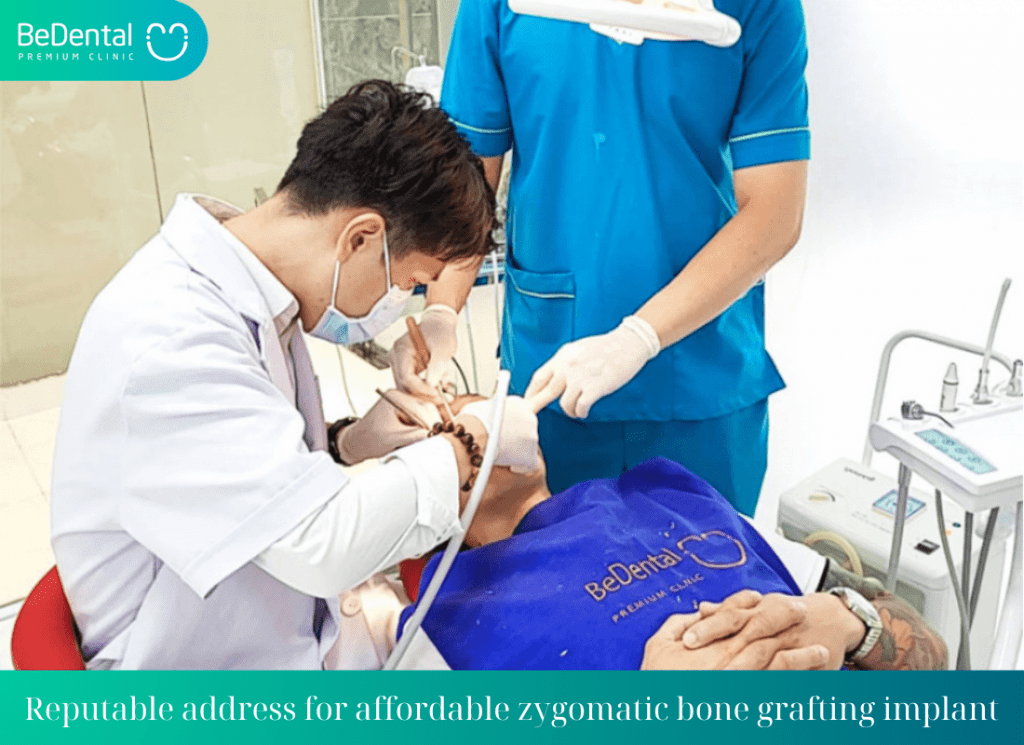
Guide to post-care after zygoma implant
Performing zygoma implant is a surgical procedure and involves invasive soft tissue intervention. Therefore, post-operative care after the implant is extremely important to ensure the best effectiveness of the implant tooth, while also avoiding dangerous complications. Specifically, you should pay attention to the following when grafting an implant at the cheekbone:
- At the beginning, you should maintain biting on gauze tightly to control bleeding.
- 1-2 days after the implant, sharp pain and discomfort will make you feel extremely uncomfortable. To alleviate the pain, you should only use painkillers prescribed by the doctor and not change medications on your own.
- In the first 1-2 days, you should only clean your mouth with saline solution. After the implant has stabilized around 3-5 days later, you can use a soft-bristled toothbrush to gently brush your teeth.
- Your diet in the days following the implant should prioritize liquids, soft, and easily digestible foods.
- To ensure safety, you should regularly visit the dentist for routine check-ups to assess overall health and see if there are any issues.
This article has helped you understand all the information about zygoma implant and when, who should perform this method. If you are in need of aesthetic tooth restoration using this implant method, contact BeDental for more specific advice.
Đặt Lịch Hẹn
Xem Hồ Sơ
Tư vấn chuyên môn bài viết:
BÁC SĨ DƯƠNG THỊ THÙY NGA
Bác sĩ chỉnh nha tổng hợp
Ngôn ngữ giao tiếp: Tiếng Việt, Tiếng Anh, Tiếng Nga





